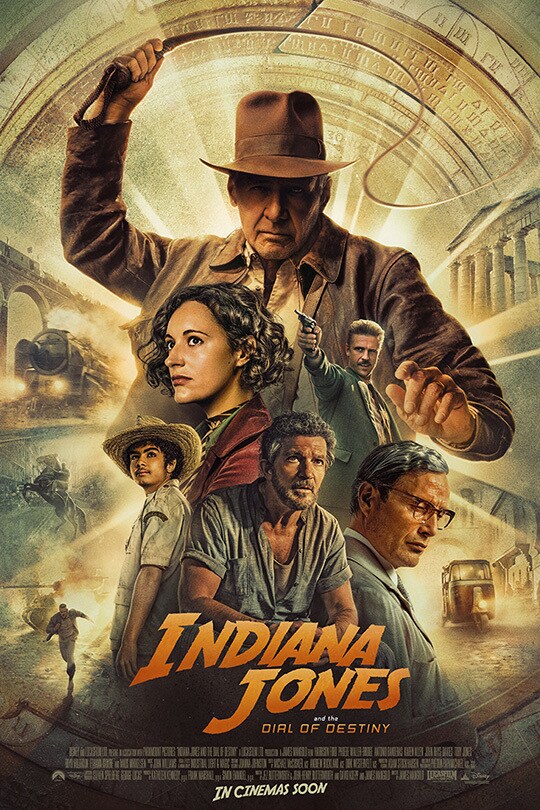Indiana Jones and the Dial of Destiny
Indiana Jones and the Dial of Destiny, 2023, 3 ½ stars
Jonesing for nostalgia
 Exclusive to MeierMovies, July 15, 2023
Exclusive to MeierMovies, July 15, 2023
After a disappointing Indiana Jones and the Kingdom of the Crystal Skull (Steven Spielberg’s worst film, in 2008), I thought my Indy nostalgia had run dry. It turns out I was wrong, and it took not the usual suspects (Spielberg and George Lucas) to prove me incorrect but, instead, the unlikely pair of director/co-writer James Mangold and a past-his-prime and occasionally youthenized Harrison Ford.
Indiana Jones and the Dial of Destiny, helmed by the aforementioned Mangold and penned with Jez and John-Henry Butterworth and David Koepp (writer of Crystal Skull but also much better films), is the trippiest and most rollicking combination of reminiscence and big-screen adventure you’ll see this summer. For the fifth and final installment in the series, Dr. Jones is on the hunt (in both 1944 and 1969) for something called the Antikythera or the Dial of Archimedes, which the Greek mathematician created in 213 B.C. If that doesn’t ring in your ears the way the Ark of the Covenant or the Holy Grail did in previous movies, that’s because the screenwriters partially invented this relic – and then added the element of time travel. Seriously. But – suspending my disbelief to the breaking point – the story kind of works. (And it even incorporates a nod, perhaps unintentional, to my favorite time-travel movie, Somewhere in Time.) Tempus fugit when you’re having amet.
Dial isn’t close to the quality of the original Raiders of the Lost Ark – what adventure movie is? – but it’s almost on par with Last Crusade, from 1989. If not for the contrived plot (even more so than past Indiana Jones films) and the overuse of CGI, it might be a contender, at least for this critic, for the best action-adventure flick of the year. But, sadly, Mangold and his accomplished crew of effects wizards can’t resist jumping the shark a few times – specifically during a wholly unnecessary and ridiculous horse chase through New York City subway tunnels. This and a couple of other action pieces make Dial seem a bit too tightly wound. But the de-ageing of Ford is superb, demonstrating just how far technology has come since Brad Pitt was briefly made younger in The Curious Case of Benjamin Button.
Phoebe Waller-Bridge, as Indy’s goddaughter, is a surprisingly effective addition to the story and a worthy successor to the previous films’ lead actresses, including Karen Allen, who makes a brief appearance in this one. Toby Jones, as Indy’s friend in the 1944 section, is also effective, as is Mads Mikkelsen as the villain. However, John Rhys-Davies (another dose of nostalgia) and Antonio Banderas feel sandwiched-in.
A nod must go to the production designers, stunt coordinators and cinematographer (Phedon Papamichael). Though nothing beats the all-practical feel of the original (with their “how did they really do that?” vibe), Dial often presents a nice blend of digital magic and traditional cinema techniques (including spectacular location shoots and use of more than a thousand extras). That added to the budget, but it was worth it, and gives Dial an air of legitimacy that Crystal Skull, with its lack of location shoots and bad CGI, never had.
So why is Dial underperforming at the box office? I suggest it’s not necessarily because of the film itself. Sure, some cinephiles might stay away because Spielberg didn’t direct. (But those same film fans should know that Mangold, with Ford v Ferrari, 3:10 to Yuma and Walk the Line, among other successes, is top-notch.) In addition, critics have been somewhat lukewarm, and the fatigue that set in after Crystal Skull can’t be dismissed. Neither can Ford’s age, 80 when Dial was shot.
But the real culprit might be society. When one can stream the movie in just a couple of months at home, in 4K, without the distractions, annoyances and hefty price of a cinema, why leave your house? Case in point: my own experience. I missed the press screening, so I caught the flick with a regular audience at Pointe Orlando Regal, in Orlando, Florida. Once considered a minor movie palace, the facility is now understaffed and poorly maintained. My complaint about the sound went unanswered, and the cinema’s sight lines were so bad that if I reclined my chair, the screen was partially blocked. And don’t get me started on the endless parade of pre-show crap that numbs the soul. I’m talking to you, Maria Menounos (host of Noovie).
At least we get to lie back in comfortable chairs, which come in handy if you’re comatose or obese. As for me, I was always reasonably happy with regular seats, which were pretty much the standard for public performances since the days of Archimedes. And this review has just come full circle.
© 2023 MeierMovies, LLC
Spoiler: Pay attention to what happens to the Dial at the end of the movie. If Indy had left it with Archimedes, it would have created a time paradox similar to the pocket watch in Somewhere in Time. But even flirting with the paradox is fascinating. (Mangold clearly relishes time travel, as he also demonstrated in Kate & Leopold, in 2001.)
For more information about this movie, visit IMDB and Wikipedia.